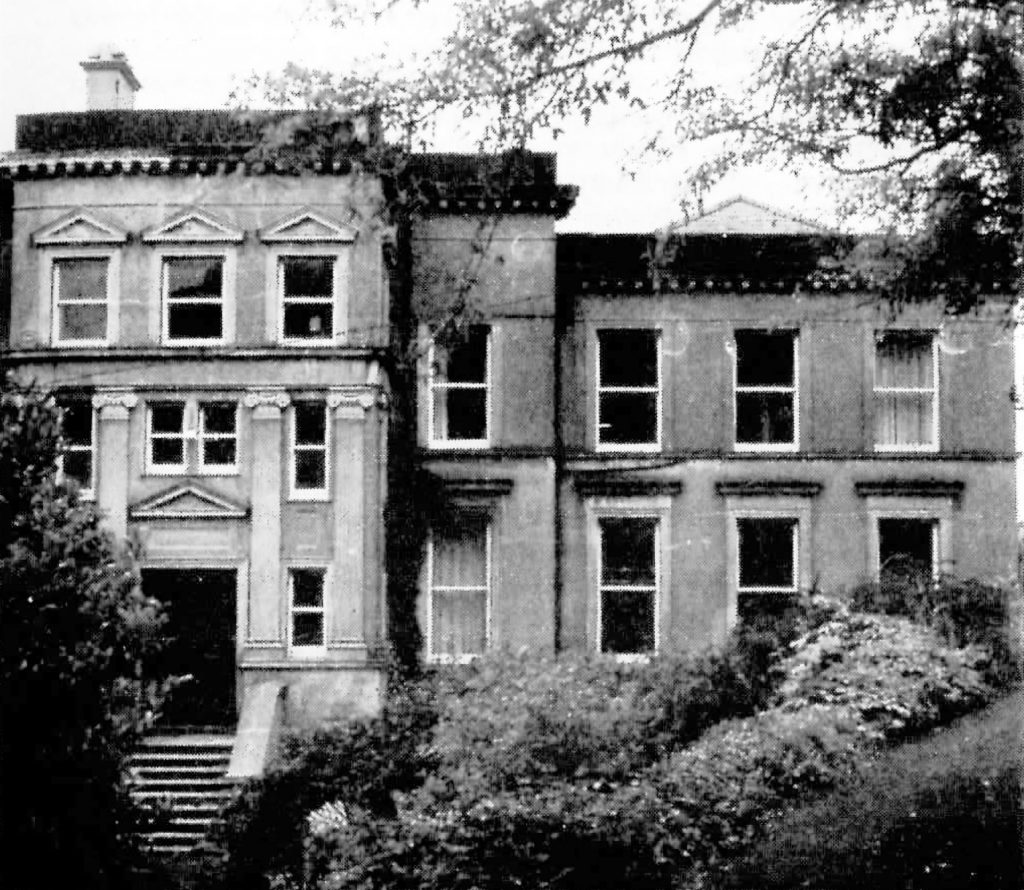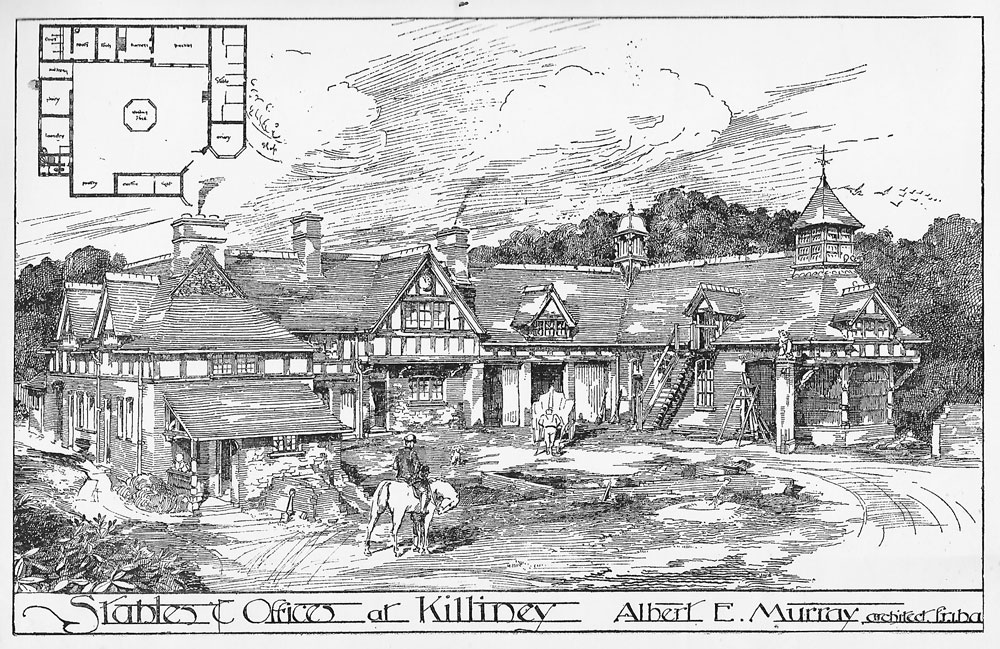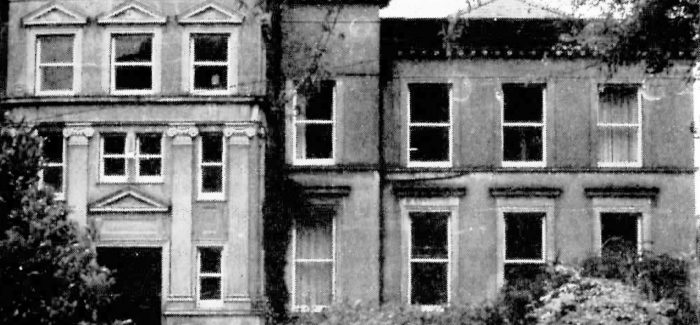Kenah Hill (formerly Stoneleigh and briefly known as Frankfort)
| Name | Kenah Hill |
|---|---|
| Previous Names | Stoneleigh, Frankfort |
| Address | St. George's Avenue |
| Year Built | 1875 (extended in 1891) |
| Architect | Albert E. Murray |
| Exists today | Yes |
| On 1888 map | Yes |
The Dubedat Connection

The history of Kenah Hill is inextricably linked to the stockbroker, Francis Edward Dubedat. A book by Maria Wootton “The Dubedat Story, Killiney to Kommetjie” provides a detailed record of the life and times of Frank and the houses of Killiney which he lived in over his colourful career. The properties include Ballybrack House (where he was born in 1851), Glenalua Lodge (where he moved to after marrying Mary Rosa Waterhouse in 1872) and Stoneleigh (which he purchased and renamed Frankfort in 1889). Maria describes the Dubedats acquisition of the house:
Also in 1889 Frank and Rosie, as they were known to family and friends, acquired from John Brooke, the house and lands known as Stoneleigh, which were situated at the top of St. George’s Avenue and Glenalua Road, Killiney. Frank also acquired land from his father in law Samuel to enable him to have a private right of way from the Glenalua side solely for his own family’s use and that of their staff.
Stoneleigh was a mansion built mainly of granite in the early 1870’s with uninterrupted views of Dublin Bay and the Dublin and Wicklow mountains. At one time the Exham family lived there. Part of the estate, which consisted of approximately fifteen acres, was still leased from them. The Exhams lived at Court-na-Farraige which is today The Killiney Court Hotel.
Frank planned to turn his estate into one of the finest in Killiney. He hired the services of Albert E. Murray, a well known Irish architect. Albert was the third generation of Murrays, whose association with architecture extended back into the eighteenth century. A cousin and partner of Albert’s grandfather William, was Francis Johnson, founder and first President of the Royal Hibernian Academy. The Murrays were associated with designing many bank buildings, including renovations to the Bank of Ireland when it changed from the Houses of Parliament to a banking office.
Albert E. Murray designed the stables and offices and probably the renovations to the existing house at Stoneleigh. The original drawings of the stables and offices were displayed at the exhibition of the Royal Hibernian Academy in December 1891.
The house was renamed Frankfort.
Landed Estates Court Auction of the estate of Robert Exham on 4th June 1875.

Stoneleigh is described in the auction particulars as a splendid new house fitted with all modern improvements on it.
Frankfort as described in a newspaper article in June 1891

“The mansion, now known as Frankfort (formerly Stoneleigh), occupies one of the most commanding sites in the county Dublin, having uninterrupted views of Dublin Bay and the Wicklow mountains. It is about a quarter of an hour’s walk from the Killiney and Ballybrack railway stations, and is approached by a newly made carriage drive with castellated gate entrance. The avenue, beautifully planted with choice flowering and evergreen shrubs, and protected on either side with strong iron fencing wire. There are also gardens, terraces and tennis ground. The residence and out offices, upon which nearly £7,000 has been already spent, are nearly completed, both masonry and carpentry being of the finest possible quality. The accommodation consists of: Seven lofty and well proportioned bedrooms and two dressingrooms with fixed lavatories; drawing, dining, morning, day and billiard rooms, spacious hall with lavatory and cloakroom, three w.c.’s, bathroom, schoolroom, splendidly appointed kitchens, wine cellars, pantries, servants rooms an electric lights and hot and cold water throughout, and the principal rooms are heated with hot water pipes. There is an enclosed yard, with coal houses, fuel rooms, and closets. The out-offices, erected on the most modern principle, contain an aviary, stabling for eight horses (Musgrave fitting), harness room, bedrooms for three coachmen, tool and out house, cowhouse with Musgrave fittings for four head of cattle, dairy, laundry, playroom 60ft long, sheds, electric house, large hay shed with corrugated iron roof, lofts for corn and hay.”
As described by the author Katharine Tynan in “The Wandering Years” (1919)
“A friend had found us a furnished house at beautiful Killiney, while we looked about us. We had not seen the house, but we knew it from repute. It was something of a freak house. It had been planned originally for his “lordly pleasure-house” by a President of the Dublin Stock Exchange, who, after a meteoric career went -phut!
It was finely planned, but the calamity had left it in a state of incompletion. Far below in the fields was the castellated gateway which led to an avenue that had begun only to be lost in the fields. I was told that the original intention had been that the carriage, or motor, passing through these gates should release a lever which would switch on electric lights all the way up the avenue.
There was a galleried hall to the house. The staircase, which was to connect the galleries and the hall, a carved wooden staircase of great beauty, brought from Italy, had been seized by the creditors; therefore there was no connection. The gallery above the hall door was for ever isolate – the dust of years and a few dead leaves drifted in it. The other gallery, leading to the bedrooms, was approached only by a mean kitchen staircase. There was a noble drawing-room, as big as a hotel lounge. It had a cheap mantelpiece, and the windows had never been properly fitted. Inhabitants of Killiney remembered tennis in that room while it was still unwindowed. They remembered when there were no hall-door steps and the hall-door swung as isolate as the gallery. The house had been finished after a fashion, but not after the financier’s dreams. There was no basement, but there was a ground floor, below the hall door level, containing a billiard room and four bedrooms, bachelors’ quarters, presumably. Outside, the house was a great gaunt edifice, like an institution.
The Vale of Shanganagh, soft below, with the little river flowing through, beyond it the mountains, range upon range. Bray Head and Wicklow Head and the sea, all lying in the country over which our windows looked. You went from room to room and every window seemed to have a more beautiful aspect than the last. The least beautiful aspect was Killiney Hill, and that, stained to all the purples and ambers and bronzes and every shade of the rose and scarlet, would have made the beauty of a less fortunate spot. We had there all the procession of dawns and sunsets and the night and the stars. The clustering roof-tops in their gardens lay at our feet. Behind the house stretched the golf links, one of the prettiest links in the world. Above it, among the rocks and heather, you could picnic as though you were a hundred miles from town. Many friends came to see us A.E., the Yeates, Susan Mitchell, Sir John and Lady Ross and others.”
Description by Peter Pearson (1998)
One of the most elevated locations in Killiney is St George’s Avenue, which was probably first developed in the 1880s when Kenah Hill was built by the Exham family. Kenah Hill, originally called Frankfort, is perched at the top of the hill among Scots pine trees. It is a very large Italianate house with rendered walls and decorative mouldings around its windows and doors. The main elevation is six bays wide and two storeys high and there is a large, half-octagonal bow facing the garden front. The main entrance is articulated by fluted Ionic pilasters. The house has lately been completely renovated and separated from its rather attractive stableyard. The enclosed yard has a distinctive cupola with louvres and a copper dome.
Thanks to Peter Pearson who contributed the piece above from his book on the architecture and history of Dun Laoghaire-Rathdown County: ‘Between the Mountains and the Sea‘ (1998), p. 73.
Renamed Kenah Hill
The Exham family who acquired the property after the departure of Frank DuBedat renamed the house Kenah Hill. The Exhams and the Kenahs, both County Cork families, were related since 1807 when Richard Exham married Alicia Kenah.They previously had an interest in the property.
Records from Thom’s Directory
KENAH HILL (Previously known as Stoneleigh and briefly as Frankfort)
1877-1884 Brooke, John (recorded as Stoneleigh)
1887 Macken, James, esq (recorded as Stoneleigh)
1888 Hewat, William, esq (recorded as Stoneleigh)
1889 Brooke, John, esq/Vacant (recorded as Stoneleigh)
1892 Vacant (recorded as Frankfort)
1900 Exham, Mrs. R. (recorded as Kenah Hill)
1910 Exham, Mrs. R.
1912 Exham, Mrs. R. (Exham, Allan O. -office & Gerard A., F.T.C.D. )
1920 Exham, Mrs. R.
1928 Exham, Mrs. R. (Exham, Allan O. & Gerard A., F.T.C.D.)
1930 Exham, Allan O. & Gerard A., F.T.C.D.
1940 Vacant
1943 Folan, P
1950 Maguire, William, B.L.
Note: The above records are incomplete
